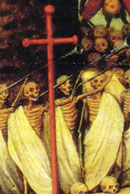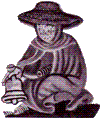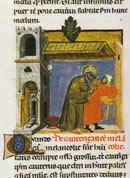R.I.P.
Christians Bury Wisdom
Mummification rituals provided the Egyptians with a detailed understanding of human anatomy, which allowed medicine to develop.
With Christianity's triumph came the burial of corpses and the loss of all such knowledge.
Game OFF
Roman doctors kept athletes fit for the games and in the process became familiar with the human body in prime condition.
In 393 Christian fanatic Emperor Theodosius I abolished the games.
Gym Babes
No More ...The pagan Romans were less concerned with their immortal soul than their mortal body.
"A person should put aside some part of the day for the care of his body. He should always make sure that he gets enough exercise especially before a meal."
– Celsus, pagan philosopher.
As great believers in 'a healthy mind is a healthy body' the pagans reasoned that if you kept fit, you would be more able to combat illness.
How frightfully secular!
 Tlos |
On Your Knees
Among the earliest basilicas converted to Christian churches (as for example at Tlos, Asia Minor) were 'gyms' (palaestra) which had been used for wrestling and physical training.
The immorality of naked athleticism was replaced by hours spent on knees in prayer.
Much better.
And We Don't Need This
Ruins of Asclepeium at Epidaurus, closed by Christian fanatics in 375 AD.
The asclepeia were temple/hospitals which offered an holistic approach to medicine. How foolish.
Biblical Guidelines –
Avoid Exercise!
"But refuse profane and old wives' fables, and exercise thyself rather unto godliness.
For bodily exercise profiteth little: but godliness is profitable unto all things, having promise of the life that now is, and of that which is to come."– St Paul (1 Timothy 4.7-8)
New for Old
With the triumph of the new sun god, Jesus Christ, the reign of the old sun god, Apollo, came to a close.
Benedict of Nursia had Apollo’s temple on Monte Cassino destroyed and built a monastery in its place.
In Rome, the great temple of Apollo on the Palatine Hill was also demolished. On the same spot, with the same stones, a church was built consecrated to St Sebastian, Like Apollo he was hailed as protector against the plague.
Similarly, the Dioscuri, the twins gods Castor and Pollux of the Romans, were supplanted by saints Cosmas and Damian, physicians and medical missionaries – mythical martyrs but none the less, patron saints of medicine.
Justinian drowns the old sun-god: Apollo's giant head, inverted, props up a column in Constantinople's biggest water tank.
540-94 Plague100,000,000 people died during plagues which sweeps northward from Egypt and Syria.
The European population was halved and the Roman Empire never recovered..
Disgrace
'The triple scourge of war, pestilence, and famine, afflicted the subjects of Justinian; and his reign is disgraced by a visible decrease of the human species, which has never been repaired in some of the fairest countries of the globe."
– Edward Gibbon (Decline & Fall, ch. 43)
Christ Rules – The Age Of Disease
"The typical peasant family of the aptly-named Dark Ages lived in a one-room, dirt-floor hovel, with a hole in the thatched roof to let out the smoke of the central fire.
The floor was strewn with hay or rushes, easy havens for lice and vermin. Garbage accumulated within.
If they were lucky, the family had a chamber pot, though more likely they relieved themselves in the corner of the hovel or in the mire and muck outside."
Christian Europe:
The great age of lice and rats, of plague and epidemic!
Christian Response
to Plague ...
Prayer! In this case, to 14th century Saint Roch who was believed to bring relief to plague sufferers.
It seems Roch himself caught the plague while on a pilgrimage to Rome. He was cured by an angel dressing his sores and a stray dog bringing him food. Good dog.
Christian Response to Toothache ...
Prayer! In this case, to Saint Apollonia, supposedly a 3rd century virgin martyr from Alexandria. She was martyred, it seems, by having all her teeth violently extracted and thus, by a curious logic, is the patroness of dentistry!
Christian Response to chilblains:
Prayer! Saint Benignus of Dijon. The yarn with this guy was that he refused to sacrifice to pagan gods or deny Christ and in consequence endured savage tortures (perhaps to his feet).
How Many levels of Nonsense ... ?
'John of Beverly (d.721) chastised the nuns of Watton for not knowing that it was perilous to bleed a patient during the moon's waxing.'
(M. McVaugh, Western Medicine, p55)
Christ Art
Triumph of Death
Brueghel (c. 1562)
Collapse of Ancient Medicine
Twilight:The triumph of ecclesiastic terrorism (see Death on the Nile) signalled the end of Alexandria as an intellectual centre. From the early 5th century onward this greatest metropolis of the Hellenic world dwindled into a Christianised backwater. With Christian dominion in Egypt came the burial of the dead and the loss of a practical knowledge which, for millennia, had been gained from the mummification of corpses. The victory of religious fanatics signalled the impending closure of the academies of secular study and with it, an end to the formal training of doctors. Any residual knowledge of ancient medical wisdom, passed on by practitioners, was condemned as 'sorcery' and this censure extended to attacks upon herbal remedies. With the victory of Christ, cleanliness and hygiene were themselves suspect. The Church condemned public bathing (as immoral and sinful) as energetically as it did the theatre, and encouraged the closure of the baths which had done so much to preserve public health in the great cities of the Roman world.
In the largesse of Justinian's early years the Bath of Zeuxippus was embellished and another built in the district of Hebdomon. But throughout his reign the Christian monarch's preoccupation (and the empire's wealth) was taken up with the construction of a plethora of costly churches, monasteries and convents. There were no 'Baths of Justinian' – Godliness came before cleanliness. Wars and civil turmoil interrupted urban water supply (and not only to the baths) throughout the Roman world. Starved of funds and with no new engineers being trained sophisticated maintenance of the baths became impossible. During the 7th and 8th centuries, all the grand baths went out of use completely, their fabric pillaged for Christian churches. Church prudishness, which viewed the human body not as a thing of beauty but rather as a temptation, had no regrets about the loss.
Skin diseases – the notorious 'boils' and 'leprosy' of the Middle Ages – became the norm rather than the exception. Until modern times, almost any disfiguring skin complaint was classed as 'leprosy.' Untreated, permanent damage would spread from skin to nerves, limbs and eyes. Lepers themselves were total outcasts. Once a charge of leprosy was made the hapless soul was banned from towns, markets, even churches. Forced to live outside the main settlements, the leper had to carry a clapper or a bell to warn passers-by of his coming. Christian 'charity' occasionally established a lazar house, not to effect any treatment to the sick but to confine the victims away from other folk. Condemned to this living hell (lepers were known as the ‘dead among the living’) these desperate souls still had their uses. For a certain breed of pious Christian 'caring' became an end in itself, the means by which the carer earned his own salvation in the world yet to come. But at least the sufferers were close to God.
6th century Catastrophe – Plague Bubonic plague first reached the Roman world in the spring of 541 AD. The trigger appears to have been a climatic shift resulting from a massive volcanic explosion on the island of Krakatoa, with atmospheric dust chilling both hemispheres. Plague-carrying rats arrived first in Roman Egypt at the port of Pelusium and from there spread to Antioch, Constantinople and other cities. The result was devastating:
Lamentably, the most virulent outbreaks of the plague coincided with the long reign of Justinian. Two centuries earlier the empire might have recovered reasonably quickly from this natural disaster but the vainglorious monarch, preoccupied with re-conquering the west, had plunged the Roman world into almost continuous warfare. The western provinces were ruined by the conflict. 30 years of warfare against the Goths in Italy, for example, (in which Rome changed hands four times) destroyed urban civilization in the peninsular and brought whole regions to famine. The provinces of north Africa and southern Spain were similarly ravaged by Justinian's armies. Records Procopius in The Secret History:
Even during Justinian's lifetime, new tribes crossed the weakened frontiers: Lombards, Moors, Slavs, Bulgars, Avars. Harvests went ungathered, livestock roamed free, vast areas of agricultural land went out of cultivation. The hungry, dirty, war-weary and displaced peoples of the Roman world were rendered extremely vulnerable to the virulence of the plague.
Lurch into Pious MadnessBut worse was to come. After the death of his wife Theodora in 548, Justinian entered a period (which lasted seventeen years, until his death) of morbid piety.
While Justinian contemplated the nature of the godhead, his churchmen had their own response to the pandemic: Church hierarchs claimed that the plague was God's punishment for not obeying church authority. With this additional whip in the hands of the Church, and corpses piling up in the street, thousands flocked into the churches in a desperation to be "saved" and avoid the lash of God's Loving Church. In the climate of terror, one group in particular, was singled out for special treatment: the Jews. Justinian outlawed the Talmud, which he described as 'puerile fabrications, insulting and blasphemous' and he curtailed the religious and civil freedoms which they had always enjoyed. Obstinate pagans were even more harshly dealt with. A fanatical monk and inquisitor, Ioannis Asiacus, was dispatched to forcibly convert any remaining pagans in Asia Minor. Plato's old academy at Athens was closed and non-Christian philosophers fled into exile. Homosexuality was outlawed. Justinian (rather like Stalin in 1953) died just as he was about to launch a new purge, this time eliminating opponents of his latest theological marvel – 'aphthartodocetism' (apparently, 'JC had always had an “incorruptible” body, not able to feel hunger, thirst or pain.') But there was no denying the demographic disaster that had befallen the Roman world. Constantinople, in the years before the plague a city of half a million souls, a century later had a population of barely 100,000. By the end of the 6th century the population of Europe had halved and many towns had simply ceased to exist. The Christian Empire's response was pious madness ...
Bizarre
beliefs about the human body.
|
|||||||||||||||||||||||||||||||||||||||||||||||||||||||||||||||
|
||||
Humorous Medicine
'Greek medicine' – that is the medicine of the Roman world – trickled back into the west over several centuries. After a darkness of 500 years, contact with the Muslim world, which had preserved and translated into Arabic many ancient manuscripts, led to re-translation into Latin of the works of Galen in particular.
'Constantine the African', a multilingual convert to Christianity from Carthage, became a monk at Monte Casino, where he made available Latin versions of Galen's Ars parva, Hippocrates' Aphorisms, and 'Haly Abbas's' Pantegni.
'With these works Western Europe now had available to it details of the theoretical medical system – Galenism – developed in antiquity.'
– I. Loudon (p56)
From
Monte Casino the knowledge went south to Salerno where, about
the year 1100 the first medieval medical school began. Others
followed at Chartres, Paris and Montpelier. The fall of Constantinople
in 1453 dispersed to the West many Greek scholars and with them,
many precious manuscripts from a pre-Christian world.
|
But whereas the 2nd century Galen had been an empiricist, ready to revise both his theories and practice, the poorly-educated quacks of the Middle Ages, who re-discovered Galen 800 years after his death, were awe-struck by his prodigious output.
Under the suspicious eye of Holy Mother Church they could do no better than 'systematize' Galen's speculations on 'humours' into a pseudo-science, which combined liberal doses of alchemy and astrology with a limited scientific understanding. Four 'qualities' (hot, cold, dry, wet), permutated with four 'elements' (fire, air, earth, water), produced four 'humours' (blood, phlegm, yellow bile, black bile) which, when, in imbalance, caused illness – or so it was thought. In this crippled form, 'Galenism' formed the medicine of Europe for the next 600 years.
Bloodletting
Thanks to mediaeval Galenism, Christian monks and nuns learned 'bleeding' techniques, designed to prevent 'toxic imbalances' and restore 'humours'. As a result, tens of thousands died each year by bleeding until the practice ended in the 16th century.
An equally ludicrous alternative to bleeding was blistering – 'drawing off sick or excessive humour with a hot iron' and with it, concoctions of lead, arsenic and cow dung, all used to treat disease! Throughout the lethal 'treatments', of course, religious penance and prayer played a central role. We were all doomed to die anyway.
The 4th Lateran Council of 1215, the first to prohibit bishops, abbots and priests from performing surgery, required physicians (themselves members of minor orders) to get their patients to confess sins to a priest before administering treatment, because:
'anima sit multo preciosior carpore'
(the
soul is far more precious than the body)
The same rationale, in fact, used to justify centuries of killing wherever ran the writ of Christ's Loving Church.
|
Sources:
Peter Murrey Jones, Medieval
Medicine (The British Library, 1998)
I. Loudon (Ed.), Western Medicine (Oxford, 1997)
David Keys, Catastrophe (Century, 1999)
John Julius Norwich, Byzantium (Viking, 1988)
Charles Freeman, The Closing of the Western Mind (Heinemann, 2002)
Jenifer Cochrane, The Illustrated History of Medicine (Tiger Books,
1996)
Norman Cantor, In the Wake of the Plague (Pocket Books, 2001)
|
||||||||||||||||||||||||||||||||||||||||||
|
|
|
||
|
Copyright © 2004
by Kenneth Humphreys.
Copying is freely permitted, provided credit is given to the author
and no material herein is sold for profit.












